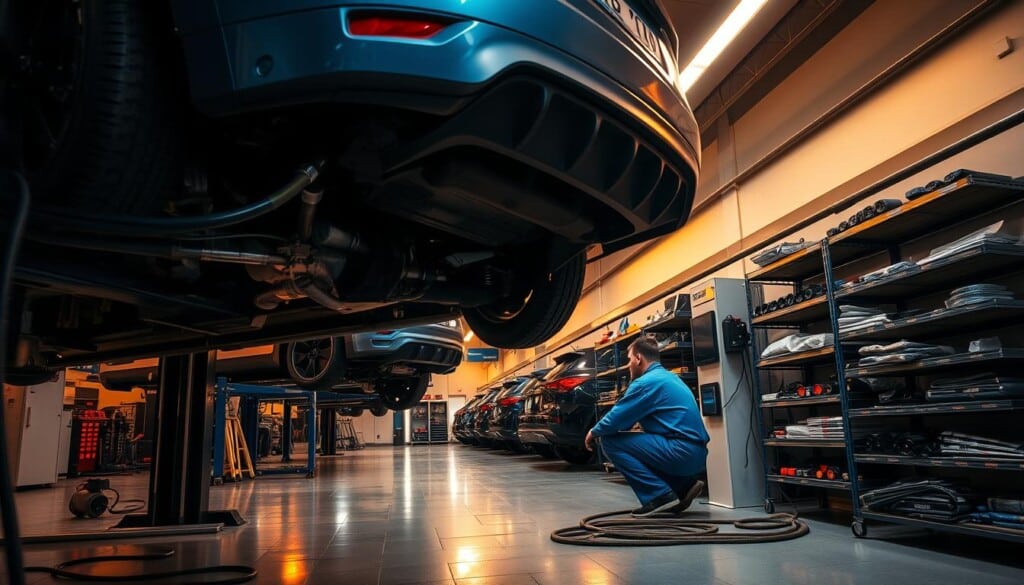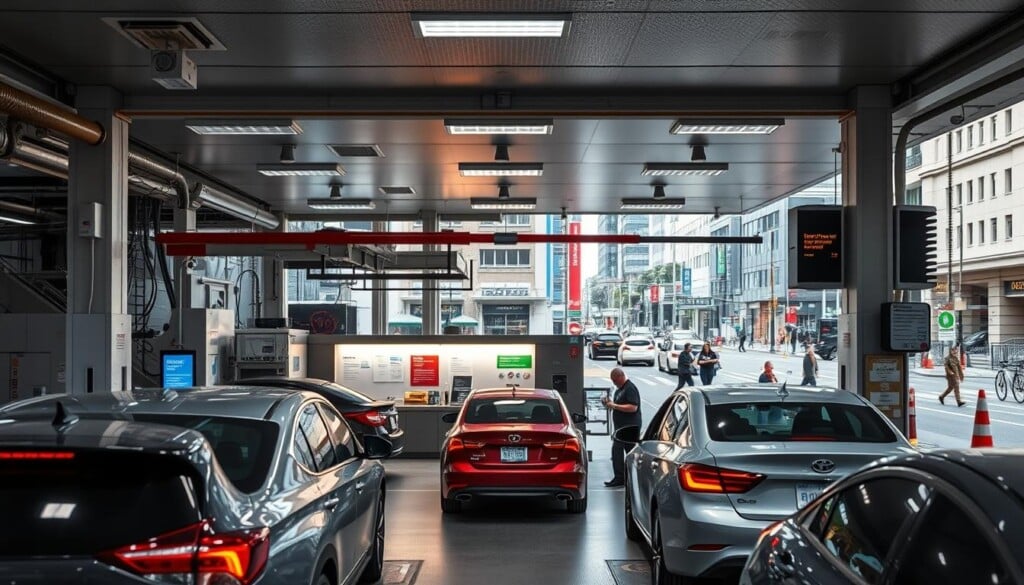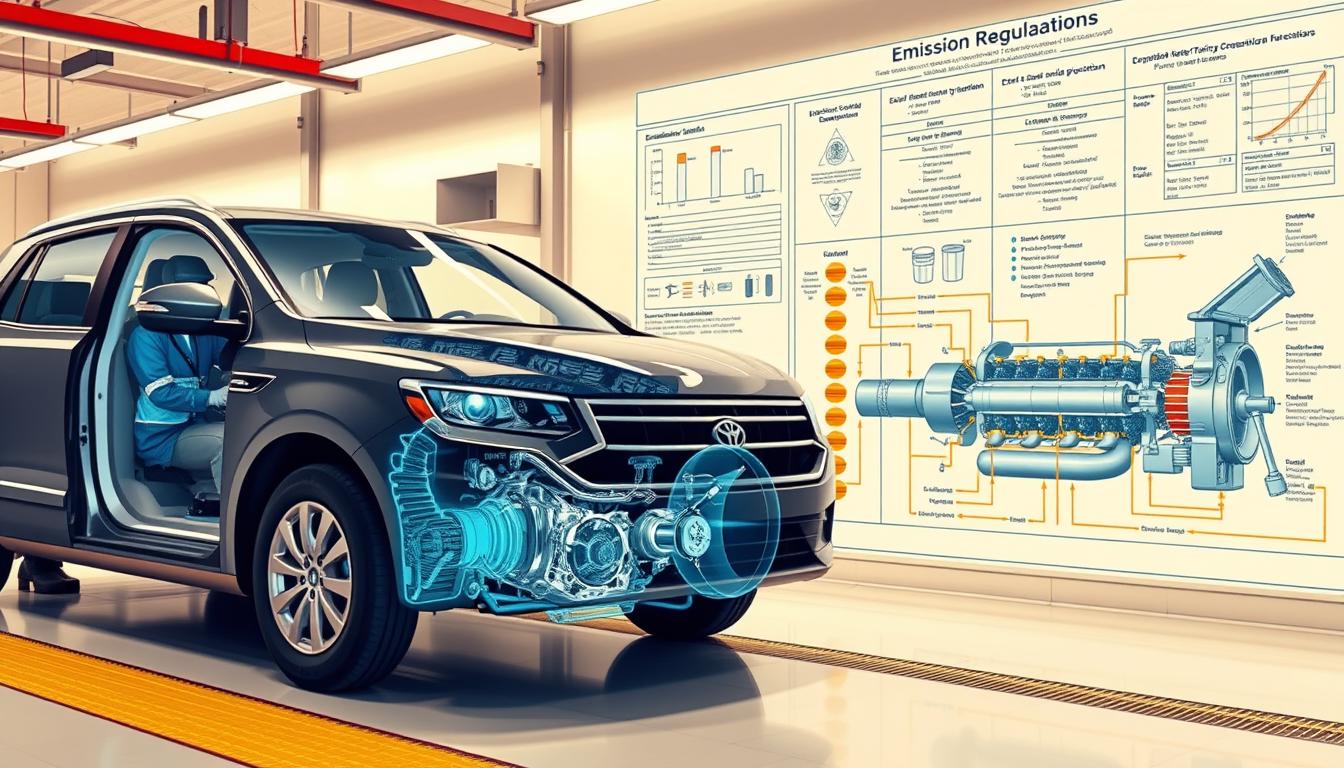Why do some people see emissions testing as a hassle, while experts see it as key to clean air? This guide explores the importance of emissions testing in the US. It shows how it keeps vehicles certified and helps protect the environment. We’ll cover everything from the testing process to legal rules, helping you understand emissions testing better.
Key Takeaways
- Emissions testing is vital for meeting federal and state emissions regulations.
- Regular vehicle emissions testing contributes significantly to air quality control.
- Understanding the types of emissions tests can help vehicle owners prepare effectively.
- Emissions certification is a necessary step in vehicle registration in many states.
- Awareness of local testing requirements can save vehicle owners time and money.
- The future of emissions testing may include technological innovations and regulatory changes.
Understanding Emissions Testing
Emissions testing checks how well vehicles release exhaust. It makes sure cars meet air quality standards. This helps protect the environment and our health.
During these tests, many parts of a car are checked. This is to see if it follows the rules.
What is Emissions Testing?
Emissions testing looks at what pollutants come out of a car’s exhaust. It’s key for keeping the air clean. The way tests are done can change based on where you are and what kind of car you have.
Why is Emissions Testing Important?
Emissions testing is important for reducing air pollution. Cars that don’t meet standards can harm the air and our health. Regular tests help make sure cars don’t pollute too much.
Key Regulations Governing Emissions
The Clean Air Act is a big law that sets emissions standards in the U.S. States have their own rules to fit their needs. These rules make sure cars are checked often. This helps control emissions better.
Types of Emissions Tests
Emissions tests are key to making sure vehicles meet environmental rules. They check different parts of a vehicle’s emissions systems. This helps cut down air pollution. Knowing about these tests helps car owners keep their emissions gear in top shape.
OBD-II Testing
OBD-II testing looks at a vehicle’s on-board diagnostic systems. It finds error codes linked to emissions. This test gets data from the car’s computer to spot problems that could cause emissions test failures.
OBD-II diagnostics are a first step to check if emissions equipment works well.
IM240 Testing
IM240 testing uses a dynamometer to mimic real driving scenarios and measure emissions. It tests how a vehicle performs at different speeds and loads. This method gives a true picture of a vehicle’s emissions, helping check if it meets local standards.
This test is vital for seeing how a vehicle’s emissions gear works under normal driving.
Tailpipe Emissions Testing
Tailpipe emissions testing captures exhaust gases from a vehicle’s tailpipe. It checks the amount of pollutants released. This test is key to see if a vehicle meets emissions limits.
By focusing on what affects air quality, tailpipe testing gives a clear view of a vehicle’s emissions systems. It makes sure emissions equipment keeps harmful emissions in check.
Who Requires Emissions Testing
Knowing who needs emissions testing is key for following emissions rules in the U.S. Many states test vehicles, mainly in cities where air quality matters. The rules for emissions tests vary by state, affecting car owners and businesses.
States Mandating Emissions Testing
Many states have started emissions testing to protect the environment. For example, California and Texas test vehicles in certain areas to fight pollution. Not every part of a state might need testing, depending on local air quality issues.
In places like Colorado and Georgia, counties have their own testing rules. This ensures vehicles meet emissions standards.
Expanding Requirements for Vehicle Types
More places are testing different types of vehicles now. This includes diesel and electric cars, in addition to regular gasoline cars. This change helps keep more vehicles in line with strict emissions rules.
Individuals vs. Businesses Obligations
Both people and companies must follow emissions rules. Car owners need to make sure their vehicles pass emissions tests to register them. Businesses with fleets also have to meet these standards.
Following these rules shows a commitment to the environment. It helps keep the air cleaner for everyone.
The Emissions Testing Process
It’s important for car owners to know about emissions testing. The test usually takes 30 to 90 minutes. Costs range from $20 to $50, depending on where you are and what kind of car you have.
What to Expect During Your Test
During emissions testing, many things can affect your experience. Technicians will check the exhaust system and use onboard diagnostic tools. This makes sure your car meets local emissions standards.
Common Duration and Costs
The length of the test can vary. It might be half an hour to an hour and a half. Costs depend on where you are and what car you drive. Knowing this helps prepare you for the test.
Preparing Your Vehicle for Testing
Getting your car ready for testing can help you pass without trouble. Check for any dashboard lights and make sure the exhaust works right. These steps can make the test go smoother and save you money.

Common Emissions Issues and Solutions
Knowing the common problems with emissions failures is key for car owners. It helps them meet emissions testing standards. Finding and fixing faulty parts keeps emissions in check and the car running well.
Identifying Faulty Vehicle Components
Many cars have issues with parts like catalytic converters, oxygen sensors, and EGR systems. These parts help control emissions. If they fail, it can lead to big problems during emissions tests.
Common Fixes for Emissions Failures
Fixing emissions failures often means repairing or replacing parts. For example, getting a new catalytic converter or oxygen sensors can help. These fixes ensure cars pass emissions tests.
Preventive Maintenance Tips
Preventive maintenance boosts your car’s emissions performance. Regular checks, timely oil changes, and quality fuels are key. Being proactive catches problems early, saving on repairs.
Local Resources: Finding Emissions Testing Stations
Finding reliable emissions testing stations is key to following the rules. LocalZ makes it easy to find nearby testing centers that fit your needs. It’s a digital guide that helps you find local services quickly, making it simpler for car owners to get what they need.
Using LocalZ to Find Nearby Test Centers
LocalZ makes finding emissions testing stations easy. It lets you search by location. This way, you can find the right place fast. The platform helps you sort through options easily.
Benefits of Local Listings for Services
Using local listings makes finding emissions testing stations better. It gives you quick access to important service details. Customer feedback helps you pick the best testing center for you. This feedback helps you make a smart choice, improving your experience.
Checking Reviews and Ratings
Reviews and ratings are key when choosing emissions testing stations. They show what others think of the services. By looking at these, you can choose a place that meets your expectations. LocalZ helps you find trusted places for your emissions test. For more info, visit this link.

The Role of LocalZ in Emissions Testing
LocalZ connects communities with local businesses for emissions testing. It offers a simple directory to find trusted services that follow emissions rules. This makes it easier for people to get their vehicles checked.
Connecting Communities with Local Businesses
LocalZ helps build ties between communities and local businesses. It boosts traffic to these places and encourages following emissions rules. People who want to support local businesses can find emissions testing services nearby.
Supporting Sustainable Practices
LocalZ promotes green practices in emissions testing businesses. It highlights companies that care about the environment. This helps people choose eco-friendly options, improving air quality for everyone.
Engaging with Local Affiliates and Organizations
LocalZ works with local groups to spread the word about emissions testing. This effort gets more people involved in protecting the environment. Together, local businesses and the community work towards cleaner air, helping both grow.
The Environmental Impact of Emissions Testing
Emissions testing is key to better air quality and tackling big environmental issues. It makes sure vehicles don’t release harmful pollutants. These pollutants harm air quality and public health.
Reducing Air Pollution and Health Risks
Emissions testing helps clean the air by cutting down on pollutants like hydrocarbons and nitrogen oxides. These pollutants can make breathing hard and cause health problems. So, strict emissions rules are vital for our health.
Contributions to Climate Change Mitigation
Following emissions rules helps fight climate change. Emissions testing helps lower greenhouse gas emissions. This supports efforts to slow global warming and protect our planet for the future.
The Broader Benefits of Cleaner Cars
Cleaner cars make the air better and improve community health. With fewer pollutants, people get sick less often. Emissions testing shows our dedication to a healthier life for everyone.

Future Trends in Emissions Testing
The world of emissions testing is changing fast. New tech and rules are leading the way. These changes mean better tests and more accurate results, helping us follow emissions standards.
Innovations in Testing Technology
New tools are coming that make finding problems easier. They help fix issues quickly, keeping cars in line with emissions rules. These tools also make testing easier for everyone involved.
Changes in Legislation on the Horizon
New laws could make emissions rules even tighter. This will affect both old cars and new electric ones. It’s important for car makers and drivers to keep up with these changes.
The Shift Toward Electric Vehicles
Electric cars are becoming more common. This means emissions tests will focus on battery health and energy use. New tests might be needed to check these areas, helping us move towards cleaner cars.
How LocalZ Enhances Local Engagement
LocalZ is key in boosting local engagement. It connects people with nearby services, like emissions testing centers. This platform makes it easy to find important resources. It also helps both businesses and consumers in the local economy.
A Guide to Utilizing LocalZ Effectively
Users can find services on LocalZ by searching or browsing listings. They can also read customer reviews. This makes it easy for people to choose wisely and engage with their community.
Promoting Community and Local Economy
LocalZ helps the local economy by promoting nearby businesses. It makes it easy for people to find local services. This supports economic growth and creates a lively community atmosphere.
Sharing Profits with Local Organizations
LocalZ gives 50% of listing fees to local organizations. This shows its dedication to improving the community. It strengthens community ties and supports initiatives that boost local engagement and growth.
Conclusion: The Importance of Emissions Testing
Emissions testing is key to keeping our air clean and our health safe. It’s important for car owners to follow these tests. This helps our environment and keeps us healthy.
A Call to Action for Vehicle Owners
Car owners need to make sure their vehicles pass emissions tests. This helps cut down on harmful air pollution. It’s not just good for them, but for everyone around them too.
Emphasizing the Role of Local Engagement
Getting involved locally is vital for cleaner air. Supporting local businesses that do emissions tests helps everyone. It makes it easier to get tests done and builds a community that cares about the planet.
Encouraging Sustainable Choices in the Community
Spreading the word about emissions testing is important. It helps communities make better choices. By focusing on emissions testing and green practices, we can all live healthier lives.

